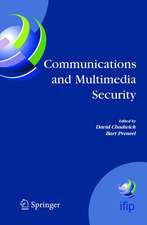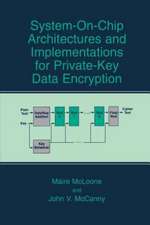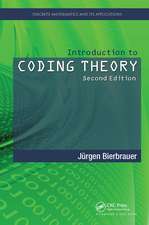A Classical Introduction to Cryptography Exercise Book
Autor Thomas Baigneres, Pascal Junod, Yi Lu, Jean Monnerat, Serge Vaudenayen Limba Engleză Hardback – 3 oct 2005
| Toate formatele și edițiile | Preț | Express |
|---|---|---|
| Paperback (1) | 353.40 lei 6-8 săpt. | |
| Springer Us – 29 oct 2010 | 353.40 lei 6-8 săpt. | |
| Hardback (1) | 361.50 lei 6-8 săpt. | |
| Springer Us – 3 oct 2005 | 361.50 lei 6-8 săpt. |
Preț: 361.50 lei
Nou
Puncte Express: 542
Preț estimativ în valută:
69.18€ • 75.12$ • 58.11£
69.18€ • 75.12$ • 58.11£
Carte tipărită la comandă
Livrare economică 22 aprilie-06 mai
Preluare comenzi: 021 569.72.76
Specificații
ISBN-13: 9780387279343
ISBN-10: 0387279342
Pagini: 254
Ilustrații: XIV, 254 p.
Dimensiuni: 156 x 235 x 20 mm
Greutate: 0.57 kg
Ediția:2006
Editura: Springer Us
Colecția Springer
Locul publicării:New York, NY, United States
ISBN-10: 0387279342
Pagini: 254
Ilustrații: XIV, 254 p.
Dimensiuni: 156 x 235 x 20 mm
Greutate: 0.57 kg
Ediția:2006
Editura: Springer Us
Colecția Springer
Locul publicării:New York, NY, United States
Public țintă
ResearchCuprins
Prehistory of Cryptography.- Conventional Cryptography.- Dedicated Conventional Cryptographic Primitives.- Conventional Security Analysis.- Security Protocols with Conventional Cryptography.- Algorithmic Algebra.- Algorithmic Number Theory.- Elements of Complexity Theory.- Public Key Cryptography.- Digital Signatures.- Cryptographic Protocols.- From Cryptography to Communication Security.
Recenzii
From the reviews:
"This companion exercise and solution book to A Classical Introduction to Cryptography … contains a carefully revised version of teaching material used by the authors and given as examinations to advanced level students of the Cryptography and Security Lecture at EPFL from 2000 to mid-2005. This book covers a majority of the subjects that make up today’s cryptography … . Exercises do not require an extensive background in mathematics, since the most important notions are introduced and discussed … ." (Cryptologia, Vol. 30, 2006)
"This companion exercise and solution book to A Classical Introduction to Cryptography … contains a carefully revised version of teaching material used by the authors and given as examinations to advanced level students of the Cryptography and Security Lecture at EPFL from 2000 to mid-2005. This book covers a majority of the subjects that make up today’s cryptography … . Exercises do not require an extensive background in mathematics, since the most important notions are introduced and discussed … ." (Cryptologia, Vol. 30, 2006)
Textul de pe ultima copertă
This companion exercise and solution book to A Classical Introduction to Cryptography: Applications for Communications Security contains a carefully revised version of teaching material. It was used by the authors or given as examinations to undergraduate and graduate-level students of the Cryptography and Security Lecture at EPFL from 2000 to mid-2005.
A Classical Introduction to Cryptography Exercise Book for A Classical Introduction to Cryptography: Applications for Communications Security covers a majority of the subjects that make up today's cryptology, such as symmetric or public-key cryptography, cryptographic protocols, design, cryptanalysis, and implementation of cryptosystems. Exercises do not require a large background in mathematics, since the most important notions are introduced and discussed in many of the exercises.
The authors expect the readers to be comfortable with basic facts of discrete probability theory, discrete mathematics, calculus, algebra, as well as computer science. Following the model of A Classical Introduction to Cryptography: Applications for Communications Security, exercises related to the more advanced parts of the textbook are marked with a star.
A Classical Introduction to Cryptography Exercise Book for A Classical Introduction to Cryptography: Applications for Communications Security covers a majority of the subjects that make up today's cryptology, such as symmetric or public-key cryptography, cryptographic protocols, design, cryptanalysis, and implementation of cryptosystems. Exercises do not require a large background in mathematics, since the most important notions are introduced and discussed in many of the exercises.
The authors expect the readers to be comfortable with basic facts of discrete probability theory, discrete mathematics, calculus, algebra, as well as computer science. Following the model of A Classical Introduction to Cryptography: Applications for Communications Security, exercises related to the more advanced parts of the textbook are marked with a star.
Caracteristici
Derived from teaching material and examinations given by the authors at the Swiss Federal Institute of Technologies (EPFL), Switzerland Topics parallel those in the textbook Serge Vaudenay is head of the Security and Cryptography Laboratory (LASEC) at EPFL Includes supplementary material: sn.pub/extras
























